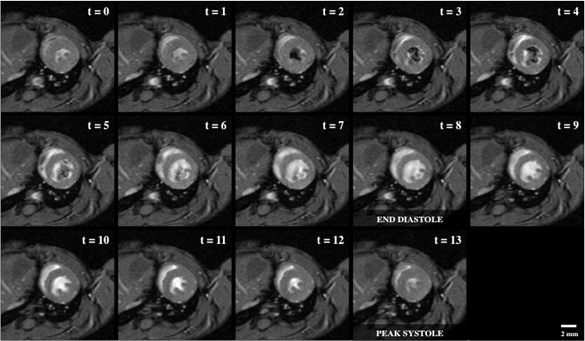Imaging a risonanza magnetica cardiaca
Panoramica
Fonte: Frederick W. Damen e Craig J. Goergen,Weldon School of Biomedical Engineering, Purdue University, West Lafayette, Indiana
In questo video, viene dimostrata la risonanza magnetica (MRI) ad alto campo e di piccolo diametro con monitoraggio fisiologico per acquisire circuiti cine gated del sistema cardiovascolare murino. Questa procedura fornisce una base per valutare la funzione ventricolare sinistra, visualizzare le reti vascolari e quantificare il movimento degli organi dovuto alla respirazione. Le modalità di imaging cardiovascolare di piccoli animali comparabili includono ultrasuoni ad alta frequenza e tomografia micro-computerizzata (TC); tuttavia, ogni modalità è associata a compromessi che dovrebbero essere considerati. Mentre gli ultrasuoni forniscono un'elevata risoluzione spaziale e temporale, gli artefatti di imaging sono comuni. Ad esempio, il tessuto denso (cioè lo sterno e le costole) può limitare la profondità di penetrazione dell'imaging e il segnale iperecoico all'interfaccia tra gas e liquido (cioè la pleura che circonda i polmoni) può offuscare il contrasto nel tessuto vicino. La micro-TC al contrario non soffre di tanti artefatti nel piano, ma ha una risoluzione temporale inferiore e un contrasto limitato dei tessuti molli. Inoltre, la micro-TC utilizza radiazioni a raggi X e spesso richiede l'uso di agenti di contrasto per visualizzare la vascolarizzazione, entrambi noti per causare effetti collaterali a dosi elevate, tra cui danni da radiazioni e lesioni renali. La risonanza magnetica cardiovascolare fornisce un buon compromesso tra queste tecniche negando la necessità di radiazioni ionizzanti e fornendo all'utente la possibilità di visualizzare senza agenti di contrasto (sebbene gli agenti di contrasto siano spesso utilizzati per la risonanza magnetica).
Questi dati sono stati acquisiti con una sequenza di risonanza magnetica Fast Low Angle SHot (FLASH) che è stata gated dai picchi R nel ciclo cardiaco e dai plateau espiratori nella respirazione. Questi eventi fisiologici sono stati monitorati attraverso elettrodi sottocutanei e un cuscino sensibile alla pressione che è stato fissato contro l'addome. Per garantire che il mouse fosse adeguatamente riscaldato, è stata inserita una sonda di temperatura rettale che è stata utilizzata per controllare l'uscita di una ventola di riscaldamento a prova di risonanza magnetica. Una volta che l'animale è stato inserito nel foro dello scanner MRI e sono state eseguite sequenze di navigazione per confermare il posizionamento, sono stati prescritti i piani di imaging FLASH gated e sono stati acquisiti i dati. Nel complesso, la risonanza magnetica ad alto campo è un potente strumento di ricerca in grado di fornire contrasto dei tessuti molli per lo studio di modelli di malattie di piccoli animali.
Procedura
1. Preparazione animale
- Identificare il topo da immaginare nella sua gabbia e trasferirlo nella camera di induzione dell'anestesia.
- Anestetizzare il mouse usando isoflurano e confermare il knockdown usando una tecnica di pizzicamento delle dita dei piedi. Prendi la zampa tra il pollice e l'indice e pizzica con fermezza per verificare la risposta. Se l'animale ritira il piede, dovresti aspettare o rifare con l'anestesia secondo il protocollo approvato.
- Verificare che tutto il personale che en
Risultati
La Figura 1 mostra un ciclo cine di una vista ad asse corto del ventricolo sinistro, che è direttamente perpendicolare all'asse base-apice del cuore e in una posizione che include i muscoli papillari.

Figura 1: Imaging cinematico luminoso di un cuore di topo con 14 istantanee ad.
Applicazione e Riepilogo
Qui, la risonanza magnetica cardiaca viene utilizzata in combinazione con il gating cardiaco e respiratorio per acquisire i dati del ciclo cine-cine del cuore murino. Mentre il cuore è stato al centro della dimostrazione, ulteriori regioni del sistema cardiovascolare possono essere immaginate seguendo la stessa metodologia. Anche se la risonanza magnetica non soffre degli stessi artefatti comunemente osservati con altre modalità di imaging, esiste un notevole compromesso con la risoluzione spaziale raggiunta per durata..
Vai a...
Video da questa raccolta:

Now Playing
Imaging a risonanza magnetica cardiaca
Biomedical Engineering
14.8K Visualizzazioni

Imaging di campioni biologici con microscopia ottica e confocale
Biomedical Engineering
35.8K Visualizzazioni

Imaging di campioni biologici con microscopio elettronico a scansione (SEM)
Biomedical Engineering
23.8K Visualizzazioni

Biodistribuzione dei vettori di nanofarmaci: applicazioni del microscopio elettronico a scansione (SEM)
Biomedical Engineering
9.3K Visualizzazioni

Imaging a ultrasuoni ad alta frequenza dell'aorta addominale
Biomedical Engineering
14.6K Visualizzazioni

Mappatura quantitativa della deformazione di un aneurisma dell'aorta addominale
Biomedical Engineering
4.6K Visualizzazioni

Tomografia fotoacustica per l'immagine di sangue e lipidi nell'aorta infrarenale
Biomedical Engineering
5.7K Visualizzazioni

Simulazioni fluidodinamiche computazionali del flusso sanguigno in un aneurisma cerebrale
Biomedical Engineering
11.8K Visualizzazioni

Imaging a fluorescenza nel vicino-infrarosso di aneurismi dell'aorta addominale
Biomedical Engineering
8.3K Visualizzazioni

Tecniche non invasive di misurazione della pressione sanguigna
Biomedical Engineering
11.9K Visualizzazioni

Acquisizione e analisi di un segnale ECG (elettrocardiogramma)
Biomedical Engineering
106.1K Visualizzazioni

Resistenza alla trazione dei biomateriali riassorbibili
Biomedical Engineering
7.5K Visualizzazioni

Imaging micro-CT di un midollo spinale di topo
Biomedical Engineering
8.0K Visualizzazioni

Visualizzazione della degenerazione dell'articolazione del ginocchio dopo lesione del LCA non invasiva nei ratti
Biomedical Engineering
8.2K Visualizzazioni

Imaging combinato SPECT e CT per la visualizzazione della funzionalità cardiaca
Biomedical Engineering
11.0K Visualizzazioni